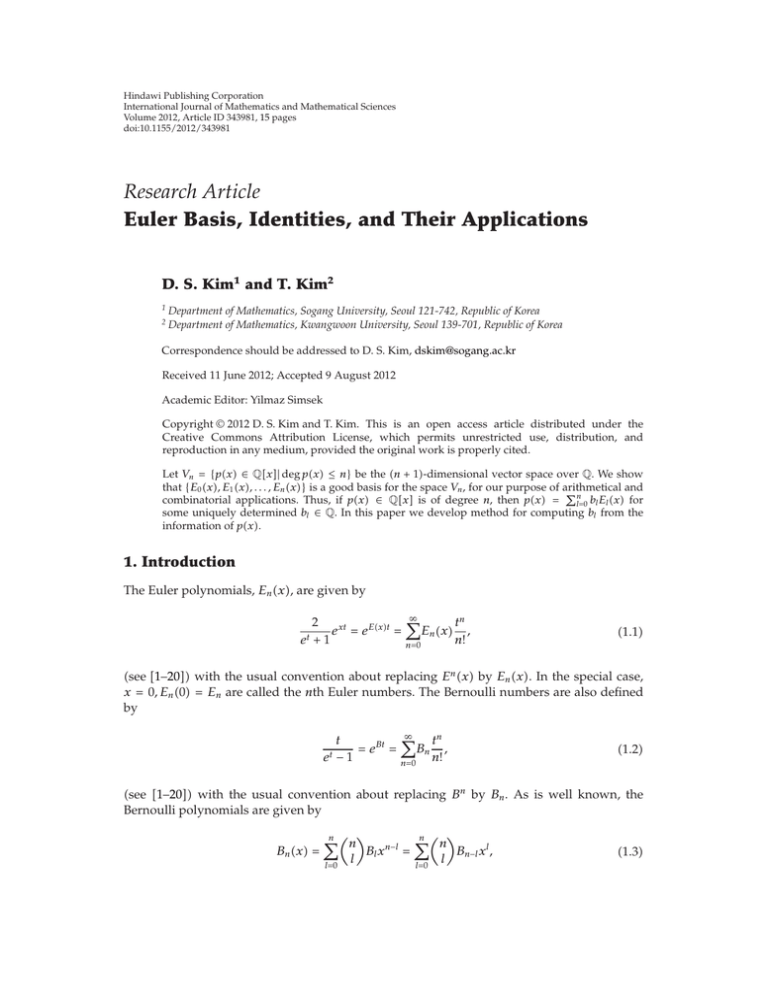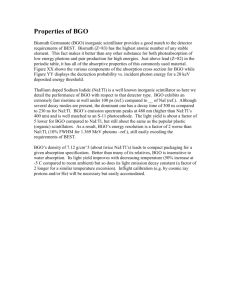Document 10455023
advertisement

Hindawi Publishing Corporation
International Journal of Mathematics and Mathematical Sciences
Volume 2012, Article ID 343981, 15 pages
doi:10.1155/2012/343981
Research Article
Euler Basis, Identities, and Their Applications
D. S. Kim1 and T. Kim2
1
2
Department of Mathematics, Sogang University, Seoul 121-742, Republic of Korea
Department of Mathematics, Kwangwoon University, Seoul 139-701, Republic of Korea
Correspondence should be addressed to D. S. Kim, dskim@sogang.ac.kr
Received 11 June 2012; Accepted 9 August 2012
Academic Editor: Yilmaz Simsek
Copyright q 2012 D. S. Kim and T. Kim. This is an open access article distributed under the
Creative Commons Attribution License, which permits unrestricted use, distribution, and
reproduction in any medium, provided the original work is properly cited.
Let Vn {px ∈ Qx| deg px ≤ n} be the n 1-dimensional vector space over Q. We show
and
that {E0 x, E1 x, . . . , En x} is a good basis for the space Vn , for our purpose of arithmetical
n
combinatorial applications. Thus, if px ∈ Qx is of degree n, then px b
E
x
for
l
l
l0
some uniquely determined bl ∈ Q. In this paper we develop method for computing bl from the
information of px.
1. Introduction
The Euler polynomials, En x, are given by
∞
tn
2
xt
Ext
,
e
e
E
x
n
n!
et 1
n0
1.1
see 1–20 with the usual convention about replacing En x by En x. In the special case,
x 0, En 0 En are called the nth Euler numbers. The Bernoulli numbers are also defined
by
∞
t
tn
Bt
,
e
B
n
n!
et − 1
n0
1.2
see 1–20 with the usual convention about replacing Bn by Bn . As is well known, the
Bernoulli polynomials are given by
Bn x n n n
n
Bl xn−l Bn−l xl ,
l
l
l0
l0
1.3
2
International Journal of Mathematics and Mathematical Sciences
see 9–15 From 1.1, 1.2, and 1.3, we note that
Bn 1 − Bn δ1,n ,
En 1 En 2δ0,n ,
1.4
where δk,n is the kronecker symbol.
Let m, n ∈ Z with m n ≥ 2. The formula
Bm xBn x m r
m!n!Bmn
B2r Bmn−2r x
n
−1m1
,
n
m
2r
2r
m n − 2r
m n!
1.5
is proved in 4–6. Let Vn {px ∈ Qx | deg px ≤ n} be the n 1-dimensional
vector space over Q. Probably, {1, x, . . . , xn } is the most natural basis for this space. But
{E0 x, E1 x, . . . , En x} is also a good basis for the space Vn , for our purpose of arithmetical
and combinatorial applications. Thus, if px ∈ Qx is of degree n, then
px n
bl El x,
1.6
l0
for some uniquely determined bl ∈ Q. Further,
bk 1 k
p 1 pk 0
2k!
k 0, 1, 2, . . . , n,
1.7
where pk x dk px/dxk . In this paper we develop methods for computing bl
from the information of px. Apply these results to arithmetically and combinatorially
interesting identities involving E0 x, E1 x, . . . , En x, B0 x, . . . , Bn x. Finally, we give some
applications of those obtained identities.
2. Euler Basis, Identities, and Their Applications
Let us take px the polynomial of degree n as follows:
px n
Bk xBn−k x.
2.1
k0
From 2.1, we have
pk x n
n 1! Bl−k xBn−l x.
n − k 1! lk
2.2
International Journal of Mathematics and Mathematical Sciences
3
By 1.7 and 2.2, we get
1 k
p 1 pk 0
2k!
n
1 n1 {Bl−k δ1,l−k Bn−l δ1,n−l Bl−k Bn−l },
k
2
lk
bk 2.3
Thus, we have
bk n
n1
Bl−k Bn−l Bn−k−1 ,
k
lk
bn−2 7 2
n n −1 ,
72
0 ≤ k ≤ n − 3,
2.4
bn−1 0.
2.5
bn n 1,
By 1.6, 2.1, 2.3, and 2.4, we get
n
Bk xBn−k x
k0
n−3 n
7 n1
Bl−k Bn−l Bn−k−1 Ek x n n2 − 1 En−2 x n 1En x.
k
72
k0
lk
2.6
Let us consider the following triple identities:
px Br xBs xBt x rstn
n
bk Ek x,
2.7
k0
where the sum runs over all r, s, t ∈ Z with r s t n. Thus, by 2.7, we get
pk x n 2n 1nn − 1 · · · n − k 3
Br xBs xBt x.
rstn−k
From 1.7 and 2.8, we have
1 k
p 1 pk 0
2k!
n2 k
{Br 1Bs 1Bt 1 Br Bs Bt }
2 rstn−k
n2 2
k
Br Bs Bt δ1,r Bs Bt Br δ1,s Bt
2
rstn−k
rstn−k
rstn−k
bk 2.8
4
International Journal of Mathematics and Mathematical Sciences
Br Bs δ1,t δ1,r δ1,s Bt δ1,r Bs δ1,t
rstn−k
rstn−k
Br δ1,s δ1,t rstn−k
rstn−k
δ1,r δ1,s δ1,t .
rstn−k
2.9
Therefore, by 2.7 and 2.9, we obtain the following theorem.
Theorem 2.1. For r, s, t ∈ Z , and n ∈ N with n ≥ 3, one has
Br xBs xBt x
rstn
n−2 1
n2
Br Bs Bt 3
Br Bs 3Bn−k−2 δk,n−3 Ek x
2
k
2 k0
rstn−k
rsn−k−1
2.10
n2
En x.
2
Let us take the polynomial px as follows:
px Br xBs xEt x.
2.11
rstn
Then, by 2.11, we get
pk x n 2n 1nn − 1 · · · n − k 3
Br xBs xEt x.
rstn−k
2.12
From 1.6, 1.7, and 2.12, we have
n2 1 k
k
p 1 p 0 k
bk {Br 1Bs 1Et 1 Br Bs Et }
2k!
2 rstn−k
n2 k
{Br δ1,r Bs δ1,s −Et 2δ0,t Br Bs Et }
2 rstn−k
n2 −
k
δ1,r Bs Et −
Br δ1,s Et 2
Br Bs δ0,t
2
rstn−k
rstn−k
rstn−k
−
δ1,r δ1,s Et 2
δ1,r Bs δ0,t 2
Br δ1,s δ0,t
rstn−k
2
rstn−k
rstn−k
δ1,r δ1,s δ0,t .
rstn−k
2.13
International Journal of Mathematics and Mathematical Sciences
Note that
bn−1
n2
Bs Et −
Br Et 2
Br Bs − 0 2B0 2B0 2 · 0
−
n−1
st0
rt0
rs1
1 n2
{−1 − 1 2B1 B1 2 2} 0.
2 n−1
5
2.14
Therefore, we obtain the following theorem.
Theorem 2.2. For n ∈ N with n ≥ 2, one has
Br xBs xEt x
rstn
n−2 1
n2
Br Bs − 2
Br Et − En−k−2 4Bn−k−1 2δk,n−2 Ek x
2
k
2 k0
rsn−k
rtn−k−1
n2
En x.
2
2.15
Remark 2.3. By the same method, we obtain the following identities.
I
Br xEs xEt x
rstn
n−2 1
n2
Br Es Et Es Et − 4
Br Es 4Bn−k − 4En−k−1 Ek x
2
k
2 k0
rstn−k
stn−k−1
rsn−k
n2
En x.
2
2.16
II
Er xEs xEt x
rstn
n−2 n2
n2
Er Es − 2En−k Ek x 3
En x.
k
2
k0
rsn−k
2.17
Let us consider the polynomial px as follows:
px Br xBs xxt .
rstn
2.18
6
International Journal of Mathematics and Mathematical Sciences
Thus, by 2.18, we get
pk x n 2n 1nn − 1 · · · n − k 3
Br xBs xxt .
rstn−k
2.19
From 1.6, 1.7, 2.18, and 2.19, we have
n2 1 k
k
p 1 p 0 k
bk Br 1Bs 1 Br Bs 0t
2k!
2 rstn−k
n2 k
Br δ1,r Bs δ1,s Br Bs 0t
2 rstn−k
n2 k
t
Br Bs Br δ1,s δ1,r Bs δ1,r δ1,s Br Bs 0 .
2
rstn−k
rstn−k
rstn−k
rstn−k
rstn−k
2.20
Here we note that
Br Bs rstn−k
n−k
Br Bs t0 rsn−k−t
n−k Br Bs
t0 rst
⎧
n−k−1
⎪
⎨ B , if k ≤ n − 1,
r
Br δ1,s r0
⎪
⎩0,
rstn−k
if k n,
⎧
n−k−1
⎪
⎨ B , if k ≤ n − 1,
r
Bs δ1,r r0
⎪
⎩
rstn−k
0,
if k n,
1, if k ≤ n − 2,
δ1,r δ1,s 0, if k n − 1 or n,
rstn−k
Br Bs 0t Br Bs , ∀k.
rstn−k
2.21
rsn−k
It is easy to show that
bn−1
1 n2
Br Bs 2
Br Bs 2B0
2 n−1
rs0
rs1
1 n2
1 n2
.
{1 2B1 B2 2} 2 n−1
2 n−1
Therefore, by 1.6, 2.18, 2.20, and 2.22, we obtain the following theorem.
2.22
International Journal of Mathematics and Mathematical Sciences
7
Theorem 2.4. For n ∈ N with n ≥ 2, one has
Br xBs xxt
rstn
n−k−1
n−2 n−k−1
1
n2
Br Bs 2
Br Bs 2
Br 1 Ek x
k
2 k0
t0 rst
r0
rsn−k
2.23
1 n2
n2
En−1 x En x.
n
2 n−1
Remark 2.5. By the same method, we can derive the following identities.
I
Br xEs xxt
rstn
n−k−1
n−2 n−k−1
n−k
1
n2
−
Br Es −
Es 2 Br 2 Ek x
k
2 k0
t0 rst
s0
r0
2.24
1 n2
n2
En x.
En−1 x n
2 n−1
II
Er xEs xxt
rstn
n−k−1
n−2 n−k
1
n2
Er Es 2
Er Es − 4 Er 4 Ek x
k
2 k0
t0 rst
r0
rsn−k
2.25
1 n2
n2
En x.
En−1 x 2
2 n−1
Now we generalize the above consideration to the completely arbitrary case. Let
px Bi1 x · · · Bir xEj1 x · · · Ejs x,
i1 ···ir j1 ···js n
2.26
where the sum runs over all nonnegative integers i1 , i2 , . . . , ir , j1 , . . . , js satisfying i1 i2 · · · ir j1 · · · js n. From 2.26, we note that
pk x n r s − 1 · · · n r s − k
i1 ···ir j1 ···js n−k
Bi1 x · · · Bir x × Ej1 x · · · Ejs x.
2.27
8
International Journal of Mathematics and Mathematical Sciences
By 1.6, 1.7, 2.18, and 2.27, we get
1 k
p 1 pk 0
2k!
1 nrs−1
Bi1 1 · · · Bir 1Ej1 1 · · · Ejs 1 Bi1 · · · Bir Ej1 · · · Ejs
k
2
i1 ···ir j1 ···js n−k
1 nrs−1
k
2
×
{Bi1 δ1,i1 · · · Bir δ1,ir bk i1 ···ir j1 ···js n−k
× −Ej1 2δ0,j1 · · · −Ejs 2δ0,js Bi1 · · · Bir Ej1 · · · Ejs
⎧
⎪
⎪
⎪
⎪
1 nrs−1 ⎨ r
s
Bi1 · · · Bia Ej1 · · · Ejc
−1c 2s−c ×
⎪
k
c
2
⎪ 0≤a≤r a
i1 ···ia j1 ···jc na−k−r
⎪
⎪
⎩ 0≤c≤s
a≥kr−n
i1 ···ir j1 ···js n−k
Bi1 · · · Bir Ej1 · · · Ejs
⎫
⎪
⎪
⎪
⎪
⎬
.
⎪
⎪
⎪
⎪
⎭
2.28
Note that
⎧
1 nrs−1 ⎨ s
Bi1 · · · Bir Ej1 · · · Ejc
bn −1c 2s−c ×
⎩0≤c≤s c
n
2
i1 ···ir j1 ···jc 0
Bi1 · · · Bir Ej1 · · · Ejs
i1 ···ir j1 ···js 0
⎫
⎬
⎭
1 nrs−1 nrs−1
,
2 − 1s 1 n
n
2
⎧
⎪
1 nrs−1 ⎨ r
s
−1c 2s−c
⎪
a
n−1
c
2
⎩r−1≤a≤r
bn−1
0≤c≤s
×
i1 ···ia j1 ···jc 1a−r
Bi1 · · · Bia Ej1 · · · Ejc
Bi1 · · · Bir Ej1 · · · Ejs
i1 ···ir j1 ···js 1
⎫
⎪
⎬
⎪
⎭
International Journal of Mathematics and Mathematical Sciences
s
1 nrs−1
1
1
s
c s−c
− r c − r s
r2 − 1 −1 2
c
n−1
2
2
2
0≤c≤s
9
1 nrs−1
1
1
1
1
r − r s − r − s 0.
n−1
2
2
2
2
2
2.29
Therefore, by 1.6, 2.28, and 2.29, we obtain the following theorem.
Theorem 2.6. For n ∈ N with n ≥ 2, one has
Bi1 x · · · Bir xEj1 x · · · Ejs x
i1 ···ir j1 ···js n
⎧
⎪
⎪
⎪
⎪
n−2
1 n r s − 1 ⎨ r
s
−1c 2s−c
⎪
k
a
c
2 k0
⎪
0≤a≤r
⎪
⎪
⎩ 0≤c≤s
a≥kr−n
×
i1 ···ia j1 ···jc na−k−r
i1 ···ir j1 ···js n−k
Bi1 · · · Bia Ej1 · · · Ejc
Bi1 · · · Bir Ej1 · · · Ejs
2.30
⎫
⎪
⎪
⎪
⎪
⎬
Ek x
⎪
⎪
⎪
⎪
⎭
nrs−1
En x.
n
Let us consider the polynomial px of degree n as
px Bi1 x · · · Bir xEj1 x · · · Ejs xxt .
ti1 ···ir j1 ···js n
2.31
Then, from 2.31, we have
pk x n r sn r s − 1 · · · n r s − k 1
Bi1 x · · · Bir xEj1 x · · · Ejs xxt .
×
i1 ···ir j1 ···js tn−k
2.32
10
International Journal of Mathematics and Mathematical Sciences
By 1.7 and 2.32, we get
bk 1 k
p 1 pk 0
2k!
1 nrs
k
2
i
1 ···ir j1 ···js tn−k
Bi1 1 · · · Bir 1Ej1 1 · · · Ejs 1 Bi1 · · · Bir Ej1 · · · Ejs 0t
1 nrs
k
2
×
i1 ···ir j1 ···js tn−k
{Bi1 δ1,i1 · · · Bir δ1,ir × −Ej0 2δ0,j1 · · · −Ejs 2δ1,js Bi1 · · · Bir Ej1 · · · Ejs 0t
2.33
From 2.33, we can derive the following equation:
⎧
⎪
⎪
⎪
⎪
na−k−r
1 nrs ⎨ r
s
bk Bi1 · · · Bia Ej1 · · · Ejc
−1c 2s−c ×
⎪
k
a
c
2
⎪
0≤a≤r
t0 i1 ···ia j1 ···jc t
⎪
⎪
⎩ 0≤c≤s
a≥kr−n
i1 ···ir j1 ···js n−k
Bi1 · · · Bir Ej1 · · · Ejs
⎫
⎪
⎪
⎪
⎪
⎬
.
⎪
⎪
⎪
⎪
⎭
2.34
Observe now that
⎧
s 1 n r s ⎨
s
bn Bi1 · · · Bir Ej1 · · · Ejc
−1c 2s−c ×
⎩ c0 c
n
2
i1 ···ir j1 ···jc 0
Bi1 · · · Bir Ej1 · · · Ejs
i1 ···ir j1 ···js 0
1 nrs nrs
,
2 − 1s 1 n
n
2
⎫
⎬
⎭
2.35
International Journal of Mathematics and Mathematical Sciences
11
⎧
⎪
1a−r
1 nrs ⎨ r
s
bn−1 Bi1 · · · Bia Ej1 · · · Ejc
−1c 2s−c ×
⎪
c
n−1
2
⎩r−1≤a≤r a
t0 i ···i j ···j t
1
0≤c≤s
Bi1 · · · Bir Ej1 · · · Ejs
i1 ···ir j1 ···js 1
a
1
c
⎫
⎪
⎬
⎪
⎭
1 nrs
1
1
1
1 nrs
1
r1− r s− r− s .
n−1
n−1
2
2
2
2
2
2
2.36
Therefore, by 1.6, 2.31, 2.34, 2.35, and 2.36, we obtain the following theorem.
Theorem 2.7. For n ∈ N with n ≥ 2, one has
Bi1 x · · · Bir xEj1 x · · · Ejs xxt
i1 ···ir j1 ···js tn
⎧
⎪
⎪
⎪
⎪
n−2 1
nrs ⎨ r
s
−1c 2s−c
⎪ 0≤a≤r a
k
c
2 k0
⎪
⎪
⎪
⎩ 0≤c≤s
a≥kr−n
×
na−k−r
t0
i1 ···ia j1 ···jc t
i1 ···ir j1 ···js n−k
Bi1 · · · Bia Ej1 · · · Ejc
Bi1 · · · Bir Ej1 · · · Ejs
2.37
⎫
⎪
⎪
⎪
⎪
⎬
Ek x
⎪
⎪
⎪
⎪
⎭
1 nrs
nrs
En x.
En−1 x n
n−1
2
Let us consider the following polynomial of degree n.
px 1
Bi x · · · Bir xEj1 x · · · Ejs x.
i ! · · · ir !j1 ! · · · js ! 1
i1 ···ir j1 ···js n 1
2.38
Thus, by 2.38, we get
pk x r sk
i1 ···ir j1
1
× Bi1 x · · · Bir xEj1 x · · · Ejs x.
i
!
·
·
·
i
!j
r 1 ! · · · js !
···j n−k 1
s
2.39
12
International Journal of Mathematics and Mathematical Sciences
From 1.7, we have
bk 1 k
p 1 pk 0
2k!
1
r sk
2k! i ···i j ···j n−k i1 ! · · · ir !j1 ! · · · js !
1
r
1
s
× Bi1 1 · · · Bir 1 × Ej1 1 · · · Ejs 1 Bi1 · · · Bir Ej1 · · · Ejs
1
r sk
2k! i ···i j ···j n−k i1 ! · · · ir !j1 ! · · · js !
1
r
1
s
× Bi1 δ1,i1 · · · Bir δ1,ir × −Ej1 2δ0,j1 · · · −Ejs 2δ0,js Bi1 · · · Bir Ej1 · · · Ejs .
2.40
Thus, by 2.40, we get
⎧
⎪
⎪
⎪
k⎪
Bi1 · · · Bia Ej1 · · · Ejc
r s ⎨ r
s
bk −1c 2s−c ×
⎪
a
c
2k! ⎪
i ! · · · ia !j1 ! · · · jc !
0≤a≤r
i1 ···ia j1 ···jc na−k−r 1
⎪
⎪
⎩ 0≤c≤s
a≥kr−n
⎫
⎪
⎪
⎪
⎪
Bi1 · · · Bir Ej1 · · · Ejs ⎬
.
i ! · · · ir !j1 ! · · · js ! ⎪
⎪
i1 ···ir j1 ···js n−k 1
⎪
⎪
⎭
Now, we note that
⎧
s r sn ⎨
s
bn −1c 2s−c
2n! ⎩ c0 c
⎫
Bi1 · · · Bir Ej1 · · · Ejc
Bi1 · · · Bir Ej1 · · · Ejs ⎬
×
i ! · · · ir !j1 ! · · · jc !
i ! · · · ir !j1 ! · · · js ! ⎭
i1 ···ir j1 ···jc 0 1
i1 ···ir j1 ···js 0 1
r sn
r sn ,
2 − 1s 1 2n!
n!
2.41
International Journal of Mathematics and Mathematical Sciences
⎧
n−1 ⎪
r s ⎨ r
s
bn−1 −1c 2s−c
c
2n − 1! ⎪
⎩r−1≤a≤r a
13
0≤c≤s
⎫
⎪
Bi1 · · · Bia Ej1 · · · Ejc
Bi1 · · · Bir Ej1 · · · Ejs ⎬
×
i ! · · · ia !j1 ! · · · jc !
i ! · · · ir !j1 ! · · · js ! ⎪
⎭
i1 ···ia j1 ···jc 1a−r 1
i1 ···ir j1 ···js 1 1
s 1
1
r sn−1
s
s
c s−c
r2 − 1 − r c − r s 0.
−1 2
c
2n − 1!
2
2
c0
2.42
Therefore, by 1.6, 2.38, 2.41, and 2.42, we obtain the following theorem.
Theorem 2.8. For n ∈ N with n ≥ 2, one has
Bi1 x · · · Bir xEj1 x · · · Ejs x
i1 ! · · · ir !j1 ! · · · js !
i1 ···ir j1 ···js n
⎧
⎪
⎪
⎪
k⎪
n−2
Bi1 · · · Bia Ej1 · · · Ejc
1 r s ⎨ r
s
−1c 2s−c ×
⎪ 0≤a≤r a
c
2 k0 k! ⎪
i ! · · · ia !j1 ! · · · jc !
i1 ···ia j1 ···jc na−k−r 1
⎪
⎪
⎩ 0≤c≤s
a≥kr−n
⎫
⎪
⎪
⎪
⎪
Bi1 · · · Bir Ej1 · · · Ejs ⎬
Ek x
i ! · · · ir !j1 ! · · · js ! ⎪
⎪
i1 ···ir j1 ···js n−k 1
⎪
⎪
⎭
r sn
En x.
n!
2.43
By the same method, we can obtain the following identity:
Bi1 x · · · Bir xEj1 x · · · Ejs xxt
i1 ! · · · ir !j1 ! · · · js !t!
i1 ···ir j1 ···js tn
⎧
⎪
⎪
⎪
k⎪
n−2
1 r s 1 ⎨ r
s
−1c 2s−c
⎪
a
c
2 k0
k!
⎪ 0≤a≤r
⎪
⎪
⎩ 0≤c≤s
a≥kr−n
14
International Journal of Mathematics and Mathematical Sciences
×
na−k−r
t0
Bi1 · · · Bia Ej1 · · · Ejc
1
i ! · · · ia !j1 ! · · · jc !
a
−
k
−
r
−
t!
n
i1 ···ia j1 ···jc t 1
⎫
⎪
⎪
⎪
⎪
Bi1 · · · Bir Ej1 · · · Ejs ⎬
E x
⎪ k
i ! · · · ir !j1 ! · · · js ! ⎪
i1 ···ir j1 ···js n−k 1
⎪
⎪
⎭
r s 1n−1
r s 1n
En−1 x En x.
2n − 1!
n!
2.44
Acknowledgments
This paper was supported by Basic Science Research Program through the National Research
Foundation of Korea NRF funded by the Ministry of Education, Science and Technology
2012R1A1A2003786.
References
1 S. Araci, D. Erdal, and J. J. Seo, “A study on the fermionic p-adic q-integral representation on Zp
associated with weighted q-Bernstein and q-Genocchi polynomials,” Abstract and Applied Analysis,
vol. 2011, Article ID 649248, 10 pages, 2011.
2 A. Bayad, “Modular properties of elliptic Bernoulli and Euler functions,” Advanced Studies in
Contemporary Mathematics, vol. 20, no. 3, pp. 389–401, 2010.
3 A. Bayad and T. Kim, “Identities involving values of Bernstein, q-Bernoulli, and q-Euler polynomials,”
Russian Journal of Mathematical Physics, vol. 18, no. 2, pp. 133–143, 2011.
4 L. Carlitz, “Note on the integral of the product of several Bernoulli polynomials,” Journal of the London
Mathematical Society, vol. 34, pp. 361–363, 1959.
5 L. Carlitz, “Multiplication formulas for products of Bernoulli and Euler polynomials,” Pacific Journal
of Mathematics, vol. 9, pp. 661–666, 1959.
6 L. Carlitz, “Arithmetic properties of generalized Bernoulli numbers,” Journal für die Reine und
Angewandte Mathematik, vol. 202, pp. 174–182, 1959.
7 N. S. Jung, H. Y. Lee, and C. S. Ryoo, “Some relations between twisted h, q-Euler numbers with
weight α and q-Bernstein polynomials with weight α,” Discrete Dynamics in Nature and Society, vol.
2011, Article ID 176296, 11 pages, 2011.
8 D. S. Kim, “Identities of symmetry for q-Euler polynomials,” Open Journal of Discrete Mathematics, vol.
1, no. 1, pp. 22–31, 2011.
9 D. S. Kim, “Identities of symmetry for generalized Euler polynomials,” International Journal of
Combinatorics, vol. 2011, Article ID 432738, 12 pages, 2011.
10 T. Kim, “On the weighted q-Bernoulli numbers and polynomials,” Advanced Studies in Contemporary
Mathematics, vol. 21, no. 2, pp. 207–215, 2011.
11 T. Kim, “Symmetry of power sum polynomials and multivariate fermionic p-adic invariant integral
on Zp ,” Russian Journal of Mathematical Physics, vol. 16, no. 1, pp. 93–96, 2009.
12 T. Kim, “Some identities on the q-Euler polynomials of higher order and q-Stirling numbers by the
fermionic p-adic integral on Zp ,” Russian Journal of Mathematical Physics, vol. 16, no. 4, pp. 484–491,
2009.
13 B. Kurt and Y. Simsek, “Notes on generalization of the Bernoulli type polynomials,” Applied
Mathematics and Computation, vol. 218, no. 3, pp. 906–911, 2011.
14 H. Y. Lee, N. S. Jung, and C. S. Ryoo, “A note on the q-Euler numbers and polynomials with weak
weight α,” Journal of Applied Mathematics, vol. 2011, Article ID 497409, 14 pages, 2011.
International Journal of Mathematics and Mathematical Sciences
15
15 H. Ozden, “p-adic distribution of the unification of the Bernoulli, Euler and Genocchi polynomials,”
Applied Mathematics and Computation, vol. 218, no. 3, pp. 970–973, 2011.
16 H. Ozden, I. N. Cangul, and Y. Simsek, “On the behavior of two variable twisted p-adic Euler q-lfunctions,” Nonlinear Analysis, vol. 71, no. 12, pp. e942–e951, 2009.
17 S.-H. Rim, A. Bayad, E.-J. Moon, J.-H. Jin, and S.-J. Lee, “A new construction on the q-Bernoulli
polynomials,” Advances in Difference Equations, vol. 2011, article 34, 2011.
18 C. S. Ryoo, “Some relations between twisted q-Euler numbers and Bernstein polynomials,” Advanced
Studies in Contemporary Mathematics, vol. 21, no. 2, pp. 217–223, 2011.
19 Y. Simsek, “Complete sum of products of h, q-extension of Euler polynomials and numbers,” Journal
of Difference Equations and Applications, vol. 16, no. 11, pp. 1331–1348, 2010.
20 Y. Simsek, “Generating functions of the twisted Bernoulli numbers and polynomials associated with
their interpolation functions,” Advanced Studies in Contemporary Mathematics, vol. 16, no. 2, pp. 251–
278, 2008.
Advances in
Operations Research
Hindawi Publishing Corporation
http://www.hindawi.com
Volume 2014
Advances in
Decision Sciences
Hindawi Publishing Corporation
http://www.hindawi.com
Volume 2014
Mathematical Problems
in Engineering
Hindawi Publishing Corporation
http://www.hindawi.com
Volume 2014
Journal of
Algebra
Hindawi Publishing Corporation
http://www.hindawi.com
Probability and Statistics
Volume 2014
The Scientific
World Journal
Hindawi Publishing Corporation
http://www.hindawi.com
Hindawi Publishing Corporation
http://www.hindawi.com
Volume 2014
International Journal of
Differential Equations
Hindawi Publishing Corporation
http://www.hindawi.com
Volume 2014
Volume 2014
Submit your manuscripts at
http://www.hindawi.com
International Journal of
Advances in
Combinatorics
Hindawi Publishing Corporation
http://www.hindawi.com
Mathematical Physics
Hindawi Publishing Corporation
http://www.hindawi.com
Volume 2014
Journal of
Complex Analysis
Hindawi Publishing Corporation
http://www.hindawi.com
Volume 2014
International
Journal of
Mathematics and
Mathematical
Sciences
Journal of
Hindawi Publishing Corporation
http://www.hindawi.com
Stochastic Analysis
Abstract and
Applied Analysis
Hindawi Publishing Corporation
http://www.hindawi.com
Hindawi Publishing Corporation
http://www.hindawi.com
International Journal of
Mathematics
Volume 2014
Volume 2014
Discrete Dynamics in
Nature and Society
Volume 2014
Volume 2014
Journal of
Journal of
Discrete Mathematics
Journal of
Volume 2014
Hindawi Publishing Corporation
http://www.hindawi.com
Applied Mathematics
Journal of
Function Spaces
Hindawi Publishing Corporation
http://www.hindawi.com
Volume 2014
Hindawi Publishing Corporation
http://www.hindawi.com
Volume 2014
Hindawi Publishing Corporation
http://www.hindawi.com
Volume 2014
Optimization
Hindawi Publishing Corporation
http://www.hindawi.com
Volume 2014
Hindawi Publishing Corporation
http://www.hindawi.com
Volume 2014





